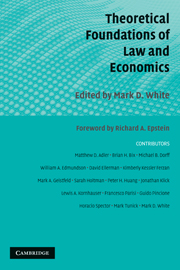Book contents
- Frontmatter
- Contents
- Foreword
- Preface
- Notes on Contributors
- PART ONE THE ROLE AND USE OF ECONOMICS IN LEGAL STUDIES
- PART TWO EFFICIENCY
- PART THREE RATIONALITY AND THE LAW
- PART FOUR VALUES AND ETHICS IN CIVIL AND CRIMINAL LAW
- 11 Law and Economics and Explanation in Contract Law
- 12 Welfare, Autonomy, and Contractual Freedom
- 13 Efficiency, Fairness, and the Economic Analysis of Tort Law
- 14 Retributivism in a World of Scarcity
- Index
- References
13 - Efficiency, Fairness, and the Economic Analysis of Tort Law
Published online by Cambridge University Press: 06 July 2009
- Frontmatter
- Contents
- Foreword
- Preface
- Notes on Contributors
- PART ONE THE ROLE AND USE OF ECONOMICS IN LEGAL STUDIES
- PART TWO EFFICIENCY
- PART THREE RATIONALITY AND THE LAW
- PART FOUR VALUES AND ETHICS IN CIVIL AND CRIMINAL LAW
- 11 Law and Economics and Explanation in Contract Law
- 12 Welfare, Autonomy, and Contractual Freedom
- 13 Efficiency, Fairness, and the Economic Analysis of Tort Law
- 14 Retributivism in a World of Scarcity
- Index
- References
Summary
Throughout its history, the economic analysis of tort law has been largely limited to one question: How should tort rules be formulated so as to minimize the social cost of accidents? Throughout its history, the economic analysis of tort law has also been controversial. The two phenomena are related. It is highly controversial whether tort law should minimize accident costs to the exclusion of fairness concerns, which in turn has fostered the belief that the economic analysis of tort law is controversial.
The controversy associated with the economic analysis of tort law was initially stirred up by the provocative work of Richard Posner. Although he was not the first to apply economic analysis to tort law, Posner strongly influenced the newly developing field by forcefully propounding the claim that tort law should maximize wealth by minimizing accident costs. The approach ultimately foundered as scholars, including Posner, recognized that cost–benefit analysis cannot determine initial entitlements, the basic architecture of any legal rule. The specification of initial entitlements, and thus the substantive content of any legal rule, depends on normative justification and not economic analysis.
This limitation of economic analysis was subsequently addressed by Louis Kaplow and Steven Shavell, who have constructed a proof showing that a “fair” tort rule can violate the Pareto principle by preventing the adoption of a welfare-maximizing, “unfair” tort rule.
- Type
- Chapter
- Information
- Theoretical Foundations of Law and Economics , pp. 234 - 252Publisher: Cambridge University PressPrint publication year: 2008



